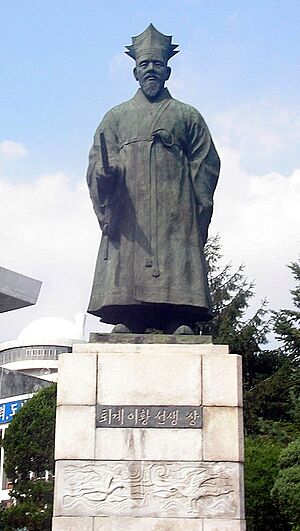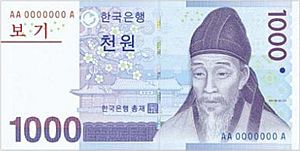Yi Hwang facts for kids
| Yi Hwang | |
 |
|
Quick facts for kids Korean name |
|
|---|---|
| Hangul |
이황
|
| Hanja |
李滉
|
| Revised Romanization | I Hwang |
| McCune–Reischauer | Yi Hwang |
| Art name | |
| Hangul |
퇴계
|
| Hanja |
退溪
|
| Revised Romanization | Toegye |
| McCune–Reischauer | T'oegye |
| Courtesy name | |
| Hangul |
경호
|
| Hanja |
景浩
|
| Revised Romanization | Gyeongho |
| McCune–Reischauer | Kyŏngho |
| Posthumous name | |
| Hangul |
문순
|
| Hanja |
文純
|
| Revised Romanization | Munsun |
| McCune–Reischauer | Munsun |
Yi Hwang (born January 3, 1502 – died January 3, 1571) was a very important Korean thinker, writer, and scholar. He lived during the Joseon Dynasty and followed a philosophy called Confucianism. He was a key person in the Neo-Confucian movement, which was a new way of thinking about Confucian ideas.
Yi Hwang started the Yeongnam School and created a special private school called Dosan Seowon. People often call him by his pen name, Toegye, which means "Retreating Creek." His courtesy name was Gyeongho.
He is seen as the most important philosopher in Korea. You can even see his picture on the 1000 Won banknote, which is a common Korean money bill. On the back of the banknote, there's a picture of his school, Dosan Seaowon.
His ideas about Neo-Confucianism were very important. They influenced not only Korea but also Japan, Taiwan, and Vietnam. Today, people in mainland China are also studying his work. His main book, Ten Diagrams on Sage Learning, was first written in classical Chinese. It has been translated into many languages, including modern Korean, Japanese, English, and more.
Some of his writings were taken by the Japanese army during an invasion of Korea.
Contents
A Scholar's Life
Yi Hwang was born in 1501 in a place called Ongye-ri, in Andong, North Gyeongsang Province. He was part of the Jinbo Yi family and was the youngest of eight children. He was a very smart child!
At age twelve, he learned about the Analects of Confucius from his uncle. He also loved the poems of Tao Yuanming and started writing his own poetry. His poem Yadang ("Pond in the Wild"), written when he was eighteen, is considered one of his best works. Around age twenty, he deeply studied the I Ching and Neo-Confucianism.
He moved to Seoul (then called Hanseong) when he was 23. In 1523, he joined the national academy, Sungkyunkwan. He passed early exams to become a government official in 1527. But he went back to Sungkyunkwan at age 33 and became friends with another scholar, Kim In-hu.
In 1534, he passed the important civil service exams with top scores. He continued his studies while working for the government. When his mother passed away at age 37, he went back home and mourned her for three years.
From age 39, he was given many different jobs. Sometimes he held several positions at once, like being a secret royal inspector in 1542. He was very honest and helped remove corrupt government officials. Because he always stuck to his principles, he was sometimes sent away from the capital city.
Yi Hwang became unhappy with the power struggles in the royal court during the later years of King Jungjong's rule. He decided to leave his political job. However, he was often asked to come out of retirement. He held several jobs in rural areas, away from the royal court.
He was the governor of Danyang at 48 and later the governor of Punggi. While in Punggi, he improved a private Neo-Confucian school called Baekundong Seowon. This school was first started by the person who had the job before him, Ju Se-bung.
In 1552, he was named the head instructor of Sungkyunkwan. But he turned down other important jobs later on. In 1560, he started the Dosan seodang. He spent his time meditating, studying, and teaching his students.
King Myeongjong tried to convince him to return to politics, but Yi Hwang wanted to focus on his studies. He finally returned to the royal court at age 67 when visitors from the Ming Dynasty came to Seoul. When King Myeongjong suddenly died, the next king, King Seonjo, asked Yi Hwang to be the minister of rites. But he said no and went back home.
However, the king kept asking Yi Hwang to return. Unable to refuse anymore, he started working again at age 68. He wrote many important advice papers, including Seonghak sipdo ("Ten Diagrams on Sage Learning"). He also gave lectures to the king about the teachings of famous Confucian scholars.
He finally retired from politics at age 70 and passed away in 1570. During his forty years in public life, he served four kings. After his death, Yi Hwang was given the highest government rank. His memory is honored in a Confucian shrine and in the shrine of King Seonjo. His students and followers later turned the Dosan seodang into the Dosan Seowon in 1574.
Yi Hwang's Teachings
Yi Hwang wrote many books about Confucianism. He followed the ideas of Chu Hsi, a famous Neo-Confucian thinker. This way of thinking believed that two forces, i and gi, are the basic parts of the universe.
Yi Hwang thought that i (the formative element) was more important. He believed i was the main force that shaped gi (the concrete element). This idea was different from another school of thought, led by Yi I, which focused more on gi.
Yi Hwang's approach, which stressed the importance of i, became the main idea of the Yeongnam School. His ideas were continued by important people like Yu Seong-ryong and Kim Seong-il.
Yi Hwang was also good at calligraphy (beautiful writing) and poetry. He wrote a collection of sijo, which is a three-line poem popular during the Joseon period.
Important Writings
These are some of the books and writings by Yi Hwang:
- 1599 — 退溪全書
- 1681 — The Ten Diagrams on Sage Learning (hangul: 성학십도, hanja: 聖學十圖)
- 1746 — 退溪集
- Outline and Explanations of the Works of Zhu Xi (hangul: 주자서절요, hanja: 朱子書節要)
- Commentary on the Heart Sutra (hangul: 심경석의, hanja: 心經釋義)
- History of Neo-Confucianism in the Song, Yuan and Ming Dynasties (hangul:송계원명이학통록, hanja:宋季元明理學通錄)
- The Four-Seven Debate (hangul: 사칠속편, hanja: 四七續篇): This book talks about Mencius's ideas with Gi Dae-seung.
Ten Diagrams on Sage Learning
Yi Hwang wrote Seonghaksipdo, or Ten Diagrams on Sage Learning, in 1568 for King Seonjo. It was a series of lessons for rulers, using examples from wise people of the past.
Confucian thinkers believed that anyone could learn to become a wise person. The new Confucians, like Yi Hwang, made this idea of wisdom seem real and possible to achieve. Yi Hwang wanted to show this path. Each chapter started with a diagram and text from a famous scholar, and then he added his own short comments.
He wanted the "Ten Diagrams" to be made into a ten-paneled screen. This way, the person looking at it would always be thinking about its lessons until they fully understood them.
Family Life
- Father: Yi Sik (born September 12, 1463 - died June 13, 1502)
- Mother:
- Biological Mother: Lady Park of the Chuncheon Park clan (died 1537) – She was Yi Sik's second wife.
- Adoptive Mother: Lady Kim of the Munso Kim clan – She was Yi Sik's first wife.
- Wives and Children:
- Lady Heo of the Gimhae Heo clan (1502 - 1528)
- Yi Jun (1523 - 1583) – Their first son.
- Yi Chae (1527 - 1550) – Their second son.
- Lady Gwon of the Andong Gwon clan (1502 - 1547) – They had no children.
- Unnamed concubine
- Yi Jeok – Their third son.
- Gisaeng Du-Hyang – They had no children.
His Legacy

A street in central Seoul, Toegyero, is named after him. As mentioned, his picture is on the 1,000 won banknote in South Korea. Also, a Taekwondo pattern called Toi-Gye is named in his honor.
Many places have been created to study Yi Hwang's work. The Toegye Studies Institute opened in Seoul in 1970. Kyungpook National University started its Toegye Institute in 1979. There's also an institute and library at Dankook University since 1986. You can find research institutes about him in Tokyo, Taiwan, Hamburg, and the United States.
A famous direct descendant of Yi Hwang is the poet and independence activist Yi Yuksa. He was also from Andong.
See also
 In Spanish: Yi Hwang para niños
In Spanish: Yi Hwang para niños
- List of Korean philosophers
- Yi I
- Neo-Confucianism

